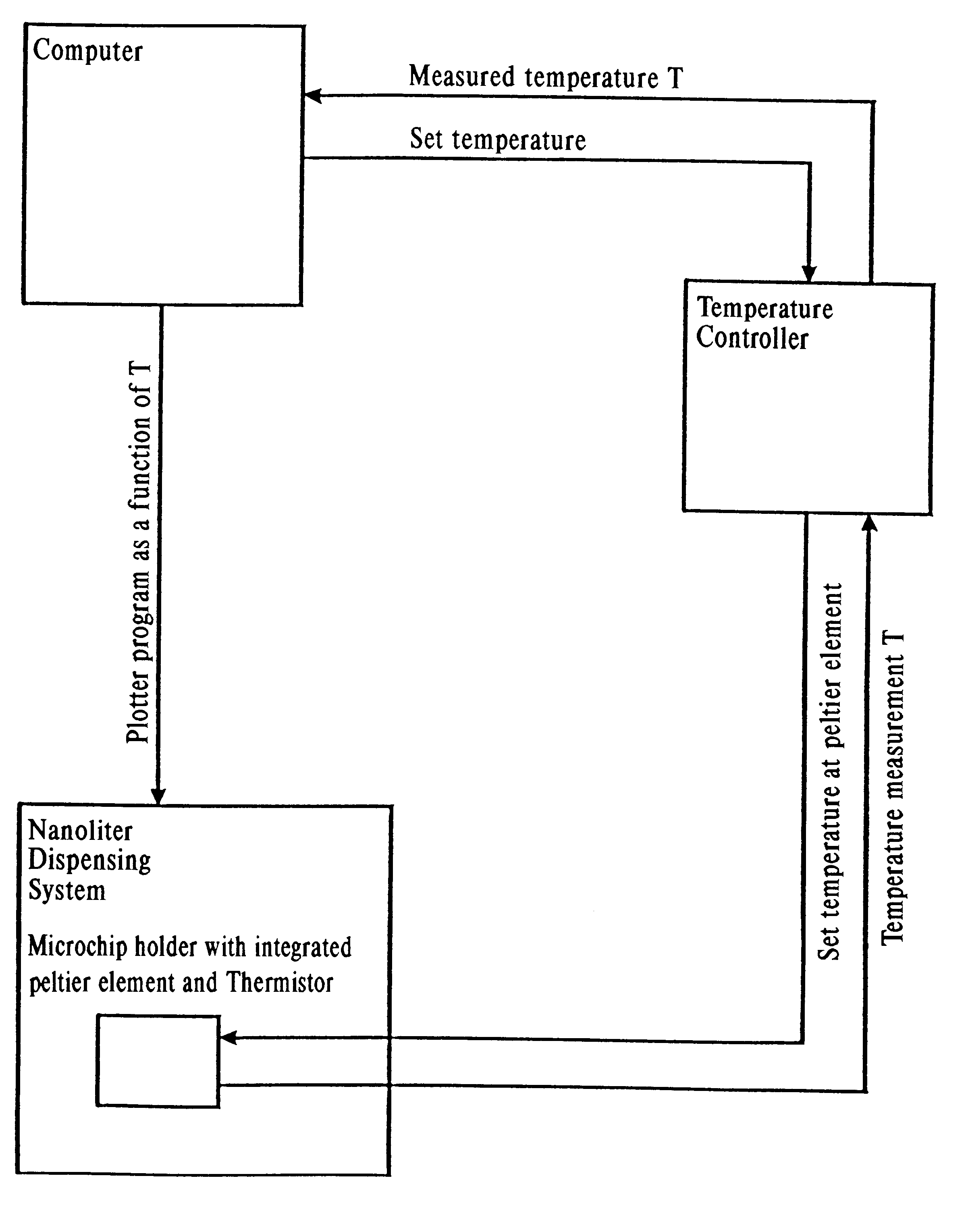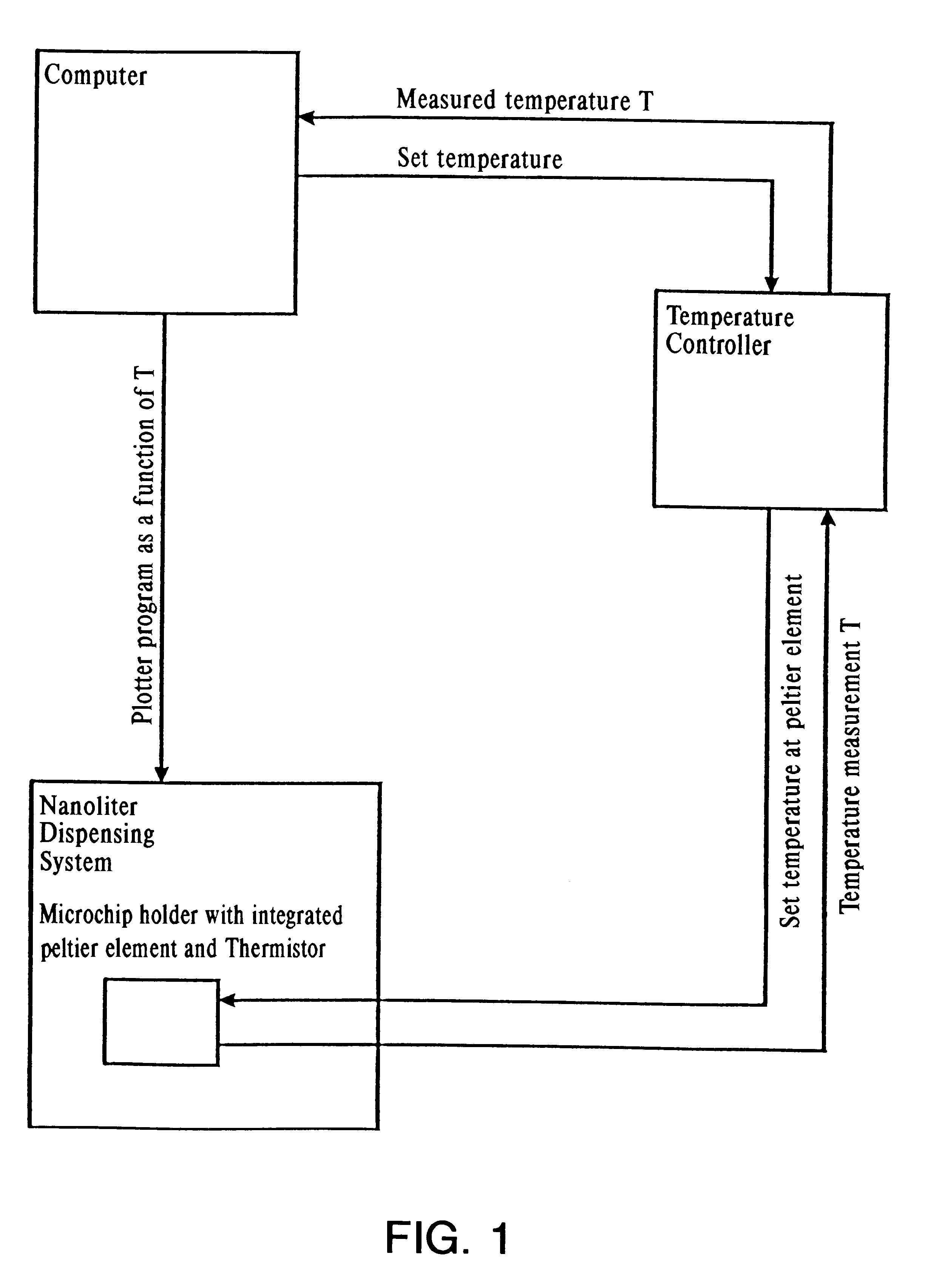Systems and methods for performing reactions in an unsealed environment
- Summary
- Abstract
- Description
- Claims
- Application Information
AI Technical Summary
Problems solved by technology
Method used
Image
Examples
example 2
Unsealed Nanoliter PCR Prior to Maldi-ms Analysis in a Single Tube Procedure
This example demonstrates that PCR products produced in an unsealed environment can be detected using matrix assisted laser desorption ionization (MALDI) mass spectrometry.
PCR is performed using pACT template, which is a pUC derivative harboring a 389 bp insert of human .beta.-actin cDNA, biotinylated primer BAct2 d(bio-GAC TGA CTA CCT CAT GAA GAT CC) (SEQ ID No. 4) and non-biotinylated primer Act4 d(GAA GCT GTA GCC GCG CTC GG) (SEQ ID No. 5). The reaction mix contains 5 .mu.l 10.times.PCR buffer (200 mM Tris-HCl (pH 8.75), 100 mM KCl, 100 mM (NH.sub.4).sub.2 SO.sub.4, 20 mM MgSO.sub.4, 1% Triton X-100, 1 mg BSA), a final concentration of 200 .mu.M of each dNTP, 10 pmol biotinylated primer, 100 pmol non-biotinylated primer, 2.5 Units Pfu DNA polymerase (Stratagene; La Jolla Calif.), 0.25 ng of template, and water to a final volume of 50 .mu.l. Amplification cycles were as follows: 30 cycles of 94.degree. C. ...
example 3
Unsealed Nanoliter Cycle Sequencing Prior to Maldi-ms Analysis in a One Well Procedure
This example demonstrates that cycle sequencing can be performed in a single well and the reaction product subsequently can be analyzed by MALDI-MS. Using the open method, no cover or sealing is used to prevent evaporation during the cycling program for the DNA sequencing reaction.
Reactions were performed essentially as described previously (see van den Boom et al., Anal. Biochem.; van den Boom et al., J.B.B.M. standard cycle sequencing paper; Koster et al., Nature Biotech.; Little et al., Anal. Chem. 69:4540-4546 (1997)). DNA sequencing of PCR products are amplified off-line on a microchip without sealing. Target DNA to be sequenced was amplified from genomic DNA or cDNA using a biotinylated primer. The corresponding PCR product was stored in a microtiter plate accessible for the piezoelectric pipette. PCR product can be placed on each position of a 96 Spectrochip.TM. support, thus allowing a seri...
example 4
RNAse Digest of Ribo-modified Oligonucleotide in a Single Tube Reaction
Liquid handling is performed using a modified 2 channel pipetting device type NP1c described in Example 1. The target site of the modified pipetting device has a 22W Peltier heating / cooling element controlled by a programmable thermoelectric temperature controller LFI-3526, and temperature is measured using PT 500 type F3132 (see Example 1).
System liquid is heated to target temperature directly in the pipette. The reaction liquid is deposited on two different positions on the SpectroChip.TM. microchip, which contains two modified hydrophobic positions to allow the reaction liquid to grow only in z-direction. One position was used as the reaction position and the second position is a dummy position to monitor the liquid loss due to evaporation (see Example 1).
Twenty nI (50 pmol) of a ribo-modified oligonucleotide is placed on the reaction position of the 96 position SpectroChip.TM. microchip, while the chip temper...
PUM
| Property | Measurement | Unit |
|---|---|---|
| Temperature | aaaaa | aaaaa |
| Hydrophilicity | aaaaa | aaaaa |
| Level | aaaaa | aaaaa |
Abstract
Description
Claims
Application Information
 Login to View More
Login to View More - R&D
- Intellectual Property
- Life Sciences
- Materials
- Tech Scout
- Unparalleled Data Quality
- Higher Quality Content
- 60% Fewer Hallucinations
Browse by: Latest US Patents, China's latest patents, Technical Efficacy Thesaurus, Application Domain, Technology Topic, Popular Technical Reports.
© 2025 PatSnap. All rights reserved.Legal|Privacy policy|Modern Slavery Act Transparency Statement|Sitemap|About US| Contact US: help@patsnap.com


